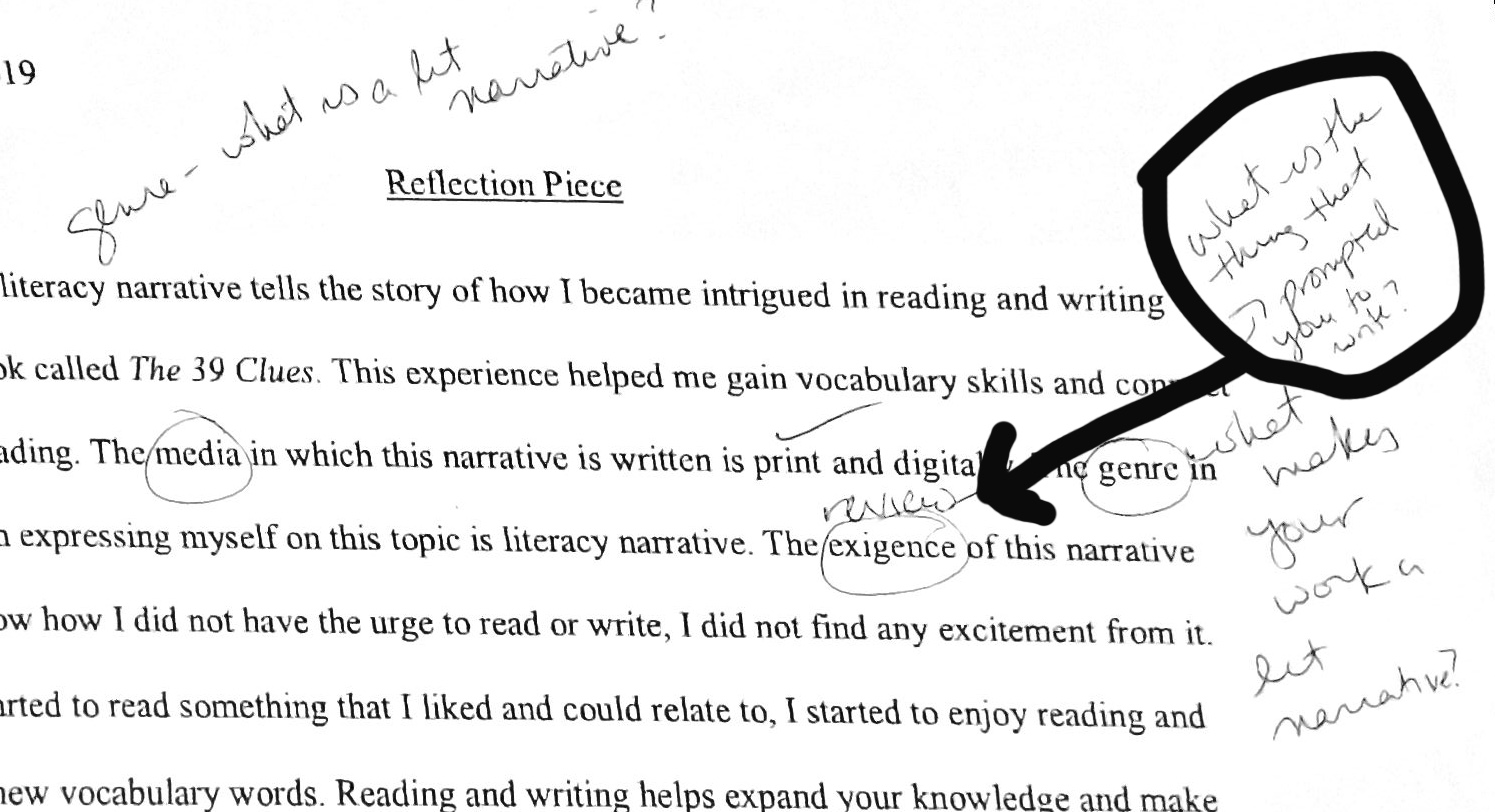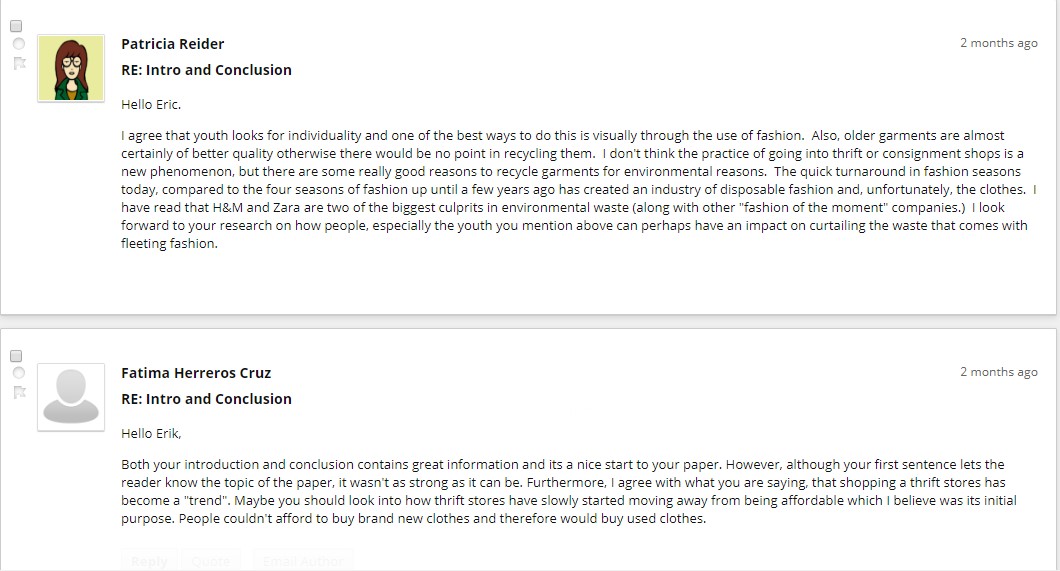There are 8 course learning outcomes each student has to achieve throughout the course with the assignments.
- Explore and analyze, in writing and reading, a variety of genres and rhetorical situations.
- Develop strategies for reading, drafting, collaborating, revising, and editing.
- Recognize and practice key rhetorical terms and strategies when engaged in writing situations.
- Engage in the collaborative and social aspects of writing processes.
- Understand and use print and digital technologies to address a range of audiences.
- Locate research sources (including academic journal articles, magazine and newspaper articles) in the library’s databases or archives and on the internet and evaluate them for credibility, accuracy, timelines, and bias.
- Compose texts that integrate your stance with appropriate sources using strategies such as summary, critical analysis, interpretation, synthesis, and argumentation.
- Practice systematic application of citation conventions.
Throughout the course, we constantly engaged in CLOs. We were required to write with different genres and analyze the composition and conventions of those genres. Each time we wrote in a different genre we were required to consider and discuss, how does my assignment meet the genre of the required essay.
CLO 1: From the first essay to that last, we explored and analyze, in writing and reading, a variety of genres and rhetorical situations. From literacy narrative to expository to argumentative essay. Each with different audience, purpose, exigence, etc. Before writing we were shown examples of each genres, to help further analyze our knowledge on the genre. In the literacy narrative it tells the story of how I became intrigued in reading and writing due to a book called The 39 Clues. The audience in this essay is different then in my argumentative, for example:
“I was not given a book that I could relate to and find excitement to read, until “The 39 Clues”… this book had a significance on my reading and writing are: it helped me to continue to read, build my vocabulary, and I was able to connect with the story.” (Literacy Narrative)
This excerpt from my lit narrative, it shows how the audience is more inclined to people who want to be interested in reading but do not know how to get started. In the argumentative essay, the audience is complete different compared to the literacy narrative, it could possibly be people who are
“fascinated on this trend and want to know why there is an attraction to 90s vintage clothing. Other people who may come across this essay are people who want to know more about fashion, and reasons why the trend is taking longer than other fashion trends”. (Argumentative Essay reflection)
CLO 2: Throughout this course I developed strategies for reading, drafting, collaborating, revising, and editing. After finding sources and coming up with our topics for our essays, we all had to make a couple drafts to make sure our writing met all the requirements. After writing drafts we worked collaboratively with our peers for peer review. In which we read each others essay and edit there work. Then when you get your essay back, you then had to revised them to meet requirements. An example of this is in this portion of my literacy narrative, the professor noted that I should explain more:

So in my revised essay I wrote, “The 39 Clues pushed me to read more mystery books and helped build my analytical skills in literature. The more I read the more into the book I got, I figured out that the type of books I liked were mystery and adventure books. This book also helped me to have a personal experience with reading, having to be forced to read in school is not the same as reading from pleasure.” I gave more insight to what I meant and how I go into reading those books.
CLO 3: With these essays I recognized and practiced key rhetorical terms and strategies.Before writing, my professor helped teach us the rhetorical terms needed to meet the requirements of each essay. The first essay did not meet all of the rhetorical elements, but throughout the semester I got better with meeting them. In the lit narrative reflection, the professor wrote on the side that I needed to review what exigence is. Exigence is the thing that prompted me to write. In my second essay, I understood what exigence meant and thoroughly explain how I met it in my essay.

CLO 4: With peer reviews we engaged in the collaborative and social aspects of writing processes. When drafts are written we had to pair up or be in groups to read each others drafts. We edit each others paper and help them with any problems they had. The peer reviews really help me be on track because it was a great way to know if I had anything missing or if I was doing great so far. I even made my sister edit my work because it is very helpful to have multiple readers editing your work. Also in the beginning of the semester we had to post our intros and body paragraphs on blackboard and our peers commented there thoughts on what we wrote. I received great feedback through this process, plus is easier to have their writing edited.


CLO 5: While writing we had to understand and use print and digital technologies to address a range of audiences. The first writing we had to do do was 3 letters addressed to different people, a close friend, your professor, and a blog. Each letter was written different because of it had a different audience. The friend was written in the least formal because the way you talk to a friend is not the if you are talking to a stranger. It is more formal when addressing to a professor because they are your mentor in the course, so you need to show respect. With a blog it is written less formal than a letter to your professor but not similar to a close friend. It also depends of your relationship to your fans of the blog and the way you express yourself.
The last essay was argumentative essay, and we had to do a power point presentation. This meant that our audiences was bigger because more people could get a hold of it.
CLO 6: We completed our essays by locating research sources (including academic journal articles, magazine and newspaper articles) in the library’s databases or archives and on the internet and evaluate them for credibility, accuracy, timelines, and bias. In some cases it was hard to find research on topics that has not been touch on. For example, when I was writing my argumentative essay, my argument was that people buy vintage clothing because they have the ability to express themselves and not because it is environmentally friendly. The clothing is Eco-friendly but that is not the only reason its attracting society. Many of the research was not arguing for either or but stating both. I had to take certain comments and statement for my use of research.’
Most of my help with citing sources in the text and in the work cited came from the Norton Filed guide. It was a requirement to buy for this course, and it really helped me. When I had a question of how to cite certain websites and articles, I use the book as a guide.
CLO 7: While writing we composed texts that integrate our stance with appropriate sources using strategies such as summary, critical analysis, interpretation, synthesis, and argumentation. This is important because it builds up your stance with meat and helps your essay feel well written.
“Another reason why there is a recent attraction to vintage fashion is the ability to express yourself due to its originality. As Gina Daria stated on her blogpost, vintage clothing can help you express yourself because it is a “timeless trend that can be a part of any wardrobe” (Daria). When wearing vintage clothing you are expressing a sense of uniqueness, because it is much more than old and used clothing.”
CLO 8: Throughout writing essays, we practiced systematic application of citation conventions. With the help of the Norton Field Guide, I learned the correct way to cite sources in my text and the work cited page. The citation is different depending on the type of source such as, article, magazine, book, website, online article, etc.
In text citation: “According to Darling’s article 90s clothing focused on “quality over quantity, for reasons both financial and cultural” (Darling).”
Works cited: Darling, E. Rebecca. “Five Reasons Vintage Clothing Is Not Just “Old Used Clothes” (Even Though It Kind of Is).” Huffpost, 6 Dec. 2017, https://www.huffpost.com/entry/five-reasons-vintage-clothes_n_6432122. Accessed 3 Mar. 2019.
Throughout the semester the Course Learning Outcomes (CLO), improved my process of writing essays. They made more sense and they began to have the correct structure. I feel confident citing my sources, and researching for credible sources.



